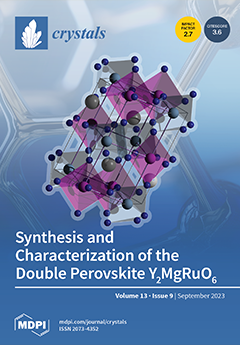A ternary nanocomposite was prepared using cerium oxide, chitosan, and graphene oxide (CeO
2/CS/GO) using a simple and cost-effective wet chemical method. The physicochemical properties of the developed ternary nanocomposite were examined using X-ray diffraction, Fourier transform infrared spectroscopy, scanning electron microscopy
[...] Read more.
A ternary nanocomposite was prepared using cerium oxide, chitosan, and graphene oxide (CeO
2/CS/GO) using a simple and cost-effective wet chemical method. The physicochemical properties of the developed ternary nanocomposite were examined using X-ray diffraction, Fourier transform infrared spectroscopy, scanning electron microscopy with energy-dispersive X-ray spectroscopy, and ultraviolet-visible spectroscopy. Furthermore, the therapeutic behavior of the developed CeO
2/CS/GO composite was assessed using anti-bacterial, anti-fungal, and anti-cancer assays. For
Escherichia coli,
Staphylococcus aureus, and
Salmonella species, 750 µg/mL of the CeO
2/CS/GO composite showed effective anti-bacterial activity, with a zone of inhibition of 9 mm. Additionally, the CeO
2/CS/GO composite’s anti-fungal activity against
Aspergillus niger was studied. The anti-cancer properties of different concentrations of the CeO
2/CS/GO composite were assessed on MCF-7 cells, and 18.8% of cells were found to be viable at the maximum concentration of 1000 µg/mL CeO
2/CS/GO and 46.37% at 125 µg/mL. The results of the hemolysis assay performed using human red blood cells and various concentrations of the CeO
2/CS/GO composite indicated that the nanocomposite possesses biological properties. Overall, it can act as a therapeutic platform for breast cancer, bacterial and fungal infections.
Full article





